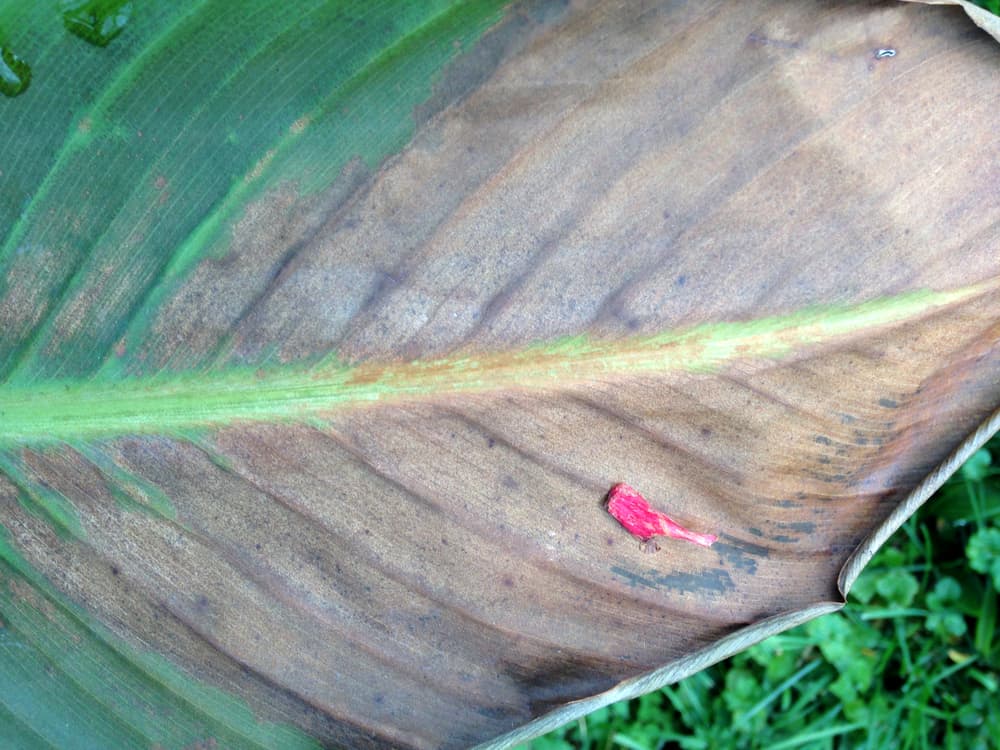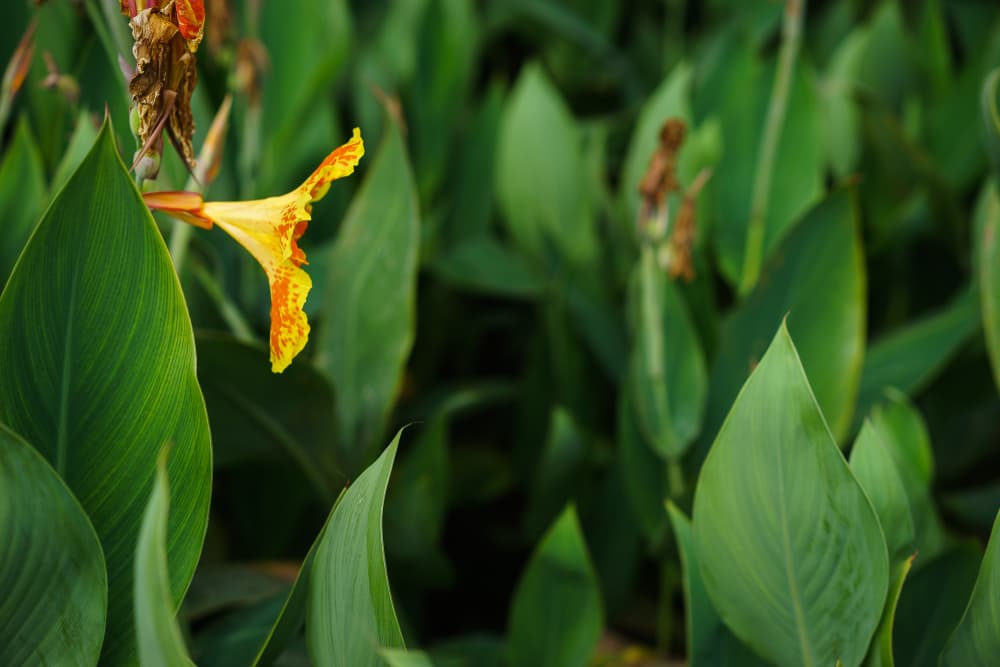How You Can Grow Beautiful Canna Lilies As A Spot And Dot Plant In Bedding Schemes

PERENNIALS > CANNA

Elizabeth is a Permaculture Garden Designer, Sustainability Consultant and Professional Writer, working as an advocate for positive change. She graduated from the University of St. Andrews with an MA in English and Philosophy and obtained a Diploma in Applied Permaculture Design from the Permaculture Association.
Reviewed By DAN ORI

Dan has over 27 years’ under his belt caring for plants and gardens. Working as a Horticultural Instructor and Consultant, he draws on a diverse range of experience that includes working as a Head Gardener, Tree Surgeon, Garden Centre Trouble Shooter, and writer of academic papers. Dan has a Level 3 Diploma in Horticulture and is currently a candidate for the RHS’s most prestigious award – The Master of Horticulture.
IN THIS GUIDE
Canna lilies are vibrant perennials that can really brighten up a garden border or container garden.
Though tender, they can make beautiful summer bedding plants – the rhizomes can overwinter in milder, more southerly parts of the UK as long as they have a good covering of mulch.
They can also be grown in a cool conservatory indoors during the summer months.
Even though they are commonly called Canna lilies, Canna are not actually lilies at all – they are actually a family of a number of species in the order Zingiberales.1Cannas. (2021, December 21). The Gardens Trust. Retrieved March 13, 2023, from https://thegardenstrust.blog/2016/02/20/cannas/

They are more closely related to gingers, bananas and arrowroot.
Typically, in the UK, we tend to think of cannas as ornamental garden plants – and many cultivars have certainly been developed for their visual appeal, but cannas are also used around the world as an edible source of starch in food production.2Imai, S. (2016, April 15). Edible Canna: A Prospective Plant Resource from South America. Academia. Retrieved March 13, 2023, from https://www.academia.edu/24407832/Edible_Canna_A_Prospective_Plant_Resource_from_South_America
Overview
| Botanical Name | Canna |
| Common Name(s) | Canna Lily |
| Plant Type | Perennial |
| Hardiness Rating | H2 / H3 |
| Foliage | Deciduous |
| Flowers | Showy flowers |
| When To Sow | April, May, June |
| Flowering Months | July, August, September, October |
| When To Prune | October, November |
Sunlight
Preferred
Full Sun / Light Shade
Exposure
Sheltered
Size
Height
1 – 2M
Spread
0.1 – 0.5M
Bloom Time
July – October
Soil
Preferred
Most Soil Types
Moisture
Moist but well drained
pH
Any
Canna lilies, both ornamental and edible species, are native to tropical and subtropical regions of the new world, from the Southern US to Northern Argentina.3Canna indica. (n.d.). Kew Royal Botanic Gardens. Retrieved March 13, 2023, from https://powo.science.kew.org/taxon/urn:lsid:ipni.org:names:319130-2
However, cultivars were mostly developed in temperate climate zones and can be grown throughout temperate zones as long as they get 6-8 hours of sunshine daily in the main growing season, and are protected from winter cold.

Canna lilies have beautiful flowers, usually in red, orange or yellow or some mix of these colours – which is why they have become such popular plants in horticulture around the world.
Why Grow Canna Lilies?
Most gardeners will grow canna lilies for their ornamental appeal.
Their impressive display of blooms that can flower in your garden from June to October (and their large leaves) make these plants firm favourites for many garden schemes.
There are also varieties which can be grown for their starchy rhizomes.
This could be something to delve into more deeply if you are interested in forest gardening, or edible landscaping.
Cannas can also be useful in organic, permaculture gardens for the generation of biomass, which can be used in mulching, composting, and returning nutrients to the soil.4Vankar, P. S., & Srivastava, J. (2018). A review-canna the wonder plant. Journal of Textile Engineering & Fashion Technology, 4(2). https://doi.org/10.15406/jteft.2018.04.00134

Interestingly, Cannas are also sometimes used in drawing pollutants for the restoration of wetland environment.5Canna can: Ornamental eliminates pollutants from stormwater runoff. (2009, December 9). Science Daily. Retrieved March 13, 2023, from https://www.sciencedaily.com/releases/2009/12/091210153659.htm
“Canna lilies have been used widely as a spot and dot plant in bedding schemes for decades,” shares Dan Ori, who has been awarded the Master Horticulturist status by the RHS.
“The spot or dot plant is a feature plant used in conjunction with groundwork (bed filling plants) and edging plants (used around the edge of a bed).
“I recommend combining Cannas with Begonia semperflorens as the groundwork and an upright pink-flowering Lobelia as an edging plant.
“If you’re growing in a large container or raised bed, I recommend switching the Lobelia to a training pink cultivar.”
Canna Varieties

If growing canna for ornamental reasons, there are many modern cultivars and hybrids to choose from.
These include the RHS AGM awarded:
- ‘Alaska’
- ‘Annaeei’
- C. x ehemannii
- ‘Endeavour’ (water canna)
- ‘Erebus’ (water canna)
- ‘General Eisenhower’
- ‘Louis Cayeux’
- ‘Musifolia’
- ‘Mystique’
- ‘Phasion’
- ‘Picasso’
- ‘Ra’ (water canna)
- ‘Russian Red’
- ‘Shenandoah’
- ‘Striata’
- ‘Verdi’
- ‘Whithelm Pride’
- ‘Wyoming’
C. edulis is the species commonly grown in agricultural cultivation.
How To Grow Canna
Canna lilies can be grown in beds or borders, or in containers.
Growing in containers in cooler regions means the plants can be taken indoors during the coldest part of the year – they will require a sunny and sheltered spot.
I have found that shelter is particularly crucial because the large leaves of the plants are often shredded by strong winds.

Most of the cannas on the list above are best grown in moist but well-drained soil.
They require a chalk, loam or sandy soil that is moderately high in fertility but will not become waterlogged.
Remember, when choosing and positioning a Canna, that these grow into large plants – some varieties can reach well over 2m in height.
Smaller varieties may be better for growing in containers, but even these will typically grow over a metre tall.

Water cannas are a little different – these can grow in a moist and well-watered border, or in a container placed in a basin of water.
They can also be placed in pots into the shallow edges of a garden pond, as long as there is no more than around 15cm of water over their roots.
Planting Canna Lilies
Cultivars will not come true from seed – if you do decide to take the harder route and grow from seed, note that cannas grown from seed will not flower, typically, until their second year.
For this reason, Canna are more generally grown from rhizomes (root sections), which are typically available for sale in late winter.
Growing From Rhizomes
In order to grow canna from rhizomes, gardeners simply place the root section into a pot of multi-purpose compost, with the rhizome just covered.

This is usually done in March or April – as soon as conditions of 10-16°C can be maintained.
If you have a conservatory, propagator or heated greenhouse, you can obviously start a bit earlier than those without heated growing spaces.
Pot-Grown Plants
If you have missed out on planting rhizomes for canna lilies this year – don’t worry.
Canna lilies can also be purchased as pot-grown plants at any point over the late spring or summer.
Early Plant Care
Canna lilies that have been grown from rhizomes should start to develop strong shoots in a matter of weeks.
As the shoots develop, it is important to make sure that you keep up with the watering of your plants.
Keep Cannas protected and undercover until all risk of frost has passed in your area.

Harden off and plant out around the end of May in most parts of the UK.
If you are growing your Canna in a bed or border of the summer, plant out at a spacing of around 75cm apart, and around 10cm deep.
Mulch well around the plants with good quality homemade compost or well-rotted manure.
If you are placing your Canna in containers, make sure that the containers you choose are at least 30cm wide.
A John Innes no. 3 loam-based compost will be ideal as a growing medium; again, place the rhizomes around 10cm deep.

Summer Care
Caring for Canna lilies over the summer months is generally fairly easy and hassle-free.
You need to make sure that you provide plenty of water during dry spells, while it is also a good idea to provide a potassium-rich organic liquid feed in mid-summer.
Canna in sheltered spots should not usually need staking, but some support may be beneficial for particularly tall specimens, or for those grown in a slightly exposed spot.
Common Problems
One piece of good news is that Canna in the UK are rarely seriously troubled by pests or diseases.

Just look out for the usual garden culprits – slugs, snails, aphids etc.
Though they can be annoying, these pests are generally pretty easy to control in a well-balanced ecosystem of an organic garden.
Rarely, the plants may develop a virus – sadly, there is no cure for this and the infected specimens must be destroyed.
But most canna growers generally experience few problems and find Canna relatively easy and trouble-free to grow.
Non-Flowering
Problems of non-flowering which can arise are usually the result of trying to grow Canna in an unsuitable spot, starting to grow rhizomes too late, a lack of water or poor soil fertility.
But take care of the soil, plant at the right time, and water well and you should not encounter issues.

Most Canna care over the summer months will involve taking a couple of simple steps to make sure that the flowers bloom for as long as possible.
First of all, it is a good idea to deadhead the spent flowers, which will encourage more to appear.
Once a particular flower spike stops budding, it is also a good idea to cut it down to the next side shoot.

This should encourage a secondary flower spike to develop.
References
- 1Cannas. (2021, December 21). The Gardens Trust. Retrieved March 13, 2023, from https://thegardenstrust.blog/2016/02/20/cannas/
- 2Imai, S. (2016, April 15). Edible Canna: A Prospective Plant Resource from South America. Academia. Retrieved March 13, 2023, from https://www.academia.edu/24407832/Edible_Canna_A_Prospective_Plant_Resource_from_South_America
- 3Canna indica. (n.d.). Kew Royal Botanic Gardens. Retrieved March 13, 2023, from https://powo.science.kew.org/taxon/urn:lsid:ipni.org:names:319130-2
- 4Vankar, P. S., & Srivastava, J. (2018). A review-canna the wonder plant. Journal of Textile Engineering & Fashion Technology, 4(2). https://doi.org/10.15406/jteft.2018.04.00134
- 5Canna can: Ornamental eliminates pollutants from stormwater runoff. (2009, December 9). Science Daily. Retrieved March 13, 2023, from https://www.sciencedaily.com/releases/2009/12/091210153659.htm
